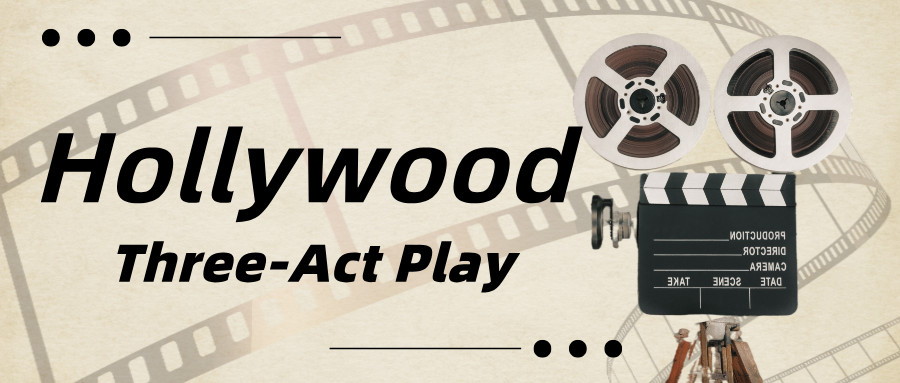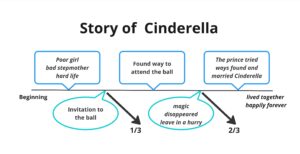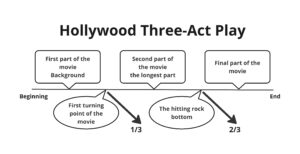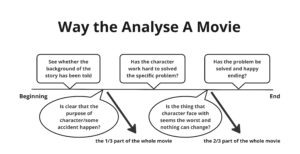How to make a Hollywood genre movie

Summary
Though following the steps of this open toolkit, learners are expected to know what the Hollywood three-act play is and how to use it to determine whether a movie belongs to the Hollywood genre or not. Also, through learning how Hollywood genre movies tell a story, they can compare it to other forms of contemporary art storytelling.
How to make a Hollywood genre movie
1.Movies as a Storytelling Form
Have you seen movies before, especially Hollywood movies, such as Zootopia (2016), The Avengers (2012) and so on?
All these kinds of movies attracted a vast amount of attention from the audience around the world, and they have a common family, Hollywood genre movies.
And the secret to making a Hollywood genre movie, is Hollywood Three-Act Play.
2.First part of the movie
Once upon a time, there was a little girl called Cinderella. She was very pretty and kind, living with a happy family. However, happiness does not last long. Her mother died and her father married to another woman, who brought two sisters into her family. Since then, Cinderella lived a hard life, doing the housework day and night.
Feel bad about the life of Cinderella?
Don’t worry! It’s just the beginning of the story.
In a 100-minute-long movie, it will always take around 30 minutes to tell the background of the story, which is the part that I described before.
Poor girl, bad stepmother, hard life, something like that.
3.First turning point of the movie
As the hard life continued, Cinderella learned how to find some fun in her poor life. She made friends with animals and finally something happened. The prince was going to hold a ball and invite all the girls to attend.
The use of the ball is the turning point of the story, the key to saving Cinderella from her poor life.
Generally, it happens in the first third of a movie.
Sometimes, it will have another name like the protagonist’s mission.
In short, an “accident” will happen, and that would totally change the character’s life.
From now on, the movie really begins.
4.Second part of the movie
Although the invitation was for every girl in the town, Cinderella was not allowed to go to the ball, and did not have the suitable dress either. However, with the help of a magic fairy godmother, Cinderella had a new dress, met the prince and fell in love.
This scene may last around 30-50 minutes within a 100-minute movie, showing what happens after the accident.
5.The hitting rock bottom
The happy time always flew quickly. The clock struck midnight, magic disappeared, and Cinderella had to leave in a hurry, leaving one of her shoes on the stairs of the palace. Prince did not know the real identity of Cinderella, and Cinderella returned home to continue her sad life.
In that short plot, the story faces the second turning point, often called hitting rock bottom, so sad and so bad.
But don’t worry, everything will turn out well!
That’s what Hollywood movies do, they almost guarantee a happy ending!
And that’s another important reason that Hollywood movies are that much attractive: dream will always come true.
6.Final part of the movie
The prince tried many ways and found Cinderella eventually, they married and lived together happily ever after.
That’s the end of the story, also the end of the many Hollywood genre movies.
The main character in the movie, after going through difficulties, completes the task and gain happiness.
7.Hollywood Three-Act Play
Ok! Let us read back of the whole story.
- Cinderella lost her mother, lived a sad life with her stepmother.
- The prince invited all the girls to the ball.
- Cinderella attended the ball with the help of a magic godmother.
- Cinderella left the ball and left one of her shoes.
- The prince tried to find her.
- The prince and Cinderella get married, and they live happily forever.

(Created by Yujia Feng in Miro)
See?
That’s how a standard Hollywood movie is made, and that’s what is called the Hollywood Three-Act Play.
The question here, would that still be Hollywood Three-Act play, if the sequence change?
Let’s try.
- The prince invited all the girls to the ball.
- Cinderella attended the ball with the help of a magic godmother.
- Cinderella left the ball and left one of her shoes.
- Cinderella lost her mother, lived a sad life with her stepmother.
- The prince tried to find her.
- The prince and Cinderella get married, and they live happily forever.
Generally, the answer is no.
It’s previously said that there is a high connection between every part of the story.
If not, the script cannot reach the purpose of controlling the change of the plot, and the mood of audience.

(Created by Yujia Feng in Miro)
8.Let us try!
Now you know what Hollywood Three-Act Play is, why not try to use the theory into another movie?
Review the movies you’ve seen before, pick one of them you like, and try to use the theory to see if the movie script fits the Three-Act Play.

(Created by Yujia Feng in Miro)
If you don’t know how to start it, try divide the whole movie into three parts, and push pause in the first third and the second third part, see what’s going on the part.
Maybe you will realise, oh that’s what the theory made in the movie!
9.Hollywood Three-Act Play and Other Forms of Contemporary Arts Storytelling
Movies, as one of the easiest and youngest forms of comprehensive storytelling arts within the art categories, have been an important part of contemporary arts.
Though the Hollywood Three-Act play is a method of film writing, it can connect with other kinds of art categories and methods of storytelling.
For example, the classical tragedy Oedipus Rex created a template of tragedy of fate, as well as the great works created by William Shakespeare, where the method of writing cause and effect is highly related to the Hollywood three-act structure.
And in contemporary art, experimental creations like the virtual reality film Black Mirror: Bandersnatch, are new ways to explore how storytelling can be expanded.
Try to discover different ways of storytelling and share your thoughts in the comments!
References: McKee, Robert. Story : Substance, Structure, Style, and the Principles of Screenwriting. London: Methuen, 1998. Byron Howard, Rich Moore, dir. Zootopia. United States: Walt Disney Studios Motion Pictures, 2016. Feature film. Joss Whedon, dir. The Avengers. United States: Walt Disney Studios Motion Pictures, 2012. Feature film. Snyder, B. "Save the Cat: the last book on screenwriting you’ll ever need, Michigan: Michael Wiese Productions." (2005). Field, Syd. Screenplay : The Foundations of Screenwriting. Third edition, Expanded edition. New York: Dell Pub., 1994. Kenneth Branagh, dir. Cinderella. United States, United Kingdom: Walt Disney Studios Motion Pictures, 2015. Feature film. Wilfred Jackson, Hamilton Luske, Clyde Geronimi, dir. Cinderella. United States: Walt Disney Productions, 1950. Feature film. Grimm, Jacob, Wilhelm Grimm, and Moira Kemp. Cinderella. London: Hamish Hamilton, 1981. Dancyger, Ken, and Jeff Rush. Alternative Scriptwriting : Beyond the Hollywood Formula. 5th ed. Burlington, Mass. ; Focal Press, 2013. https://doi.org/10.4324/9780240522470. Sophocles., and R. D. (Roger David) Dawe. Sophoclis Oedipus Rex. 3 edition. Stutgardiae: Teubner, 1996. David Slade, dir. Black Mirror: Bandersnatch. United Kingdom: Netflix, 2018. Feature film. Lopera-Mármol, Marta, Ivan Pintor, and Manel Jiménez-Morales. “CHOOSE YOUR ADVENTURE: IMMERSIVE AUDIENCES. BLACK MIRROR: BANDERSNATCH.” Atalante (Valencia, Spain), no. 35 (2023): 1–13. Zou, Jing-Yao, and Sae-Hoon Kim. “A Study of Flow Theory in Interactive Movies: A Focus on Black Mirror: Bandersnatch.” Journal of Digital Contents Society 24, no. 11 (2023): 2701–10. https://doi.org/10.9728/dcs.2023.24.11.2701. Rezk, Anna Marie, Mads Haahr, Charlie Hargood, Anne-Gwenn Bosser, David E Millard, Anne-Gwenn Bosser, David E Millard, and Charlie Hargood. “The Case for Invisibility: Understanding and Improving Agency in Black Mirror’s Bandersnatch and Other Interactive Digital Narrative Works.” In Interactive Storytelling, 12497:178–89. Switzerland: Springer International Publishing AG, 2020. https://doi.org/10.1007/978-3-030-62516-0_16.


